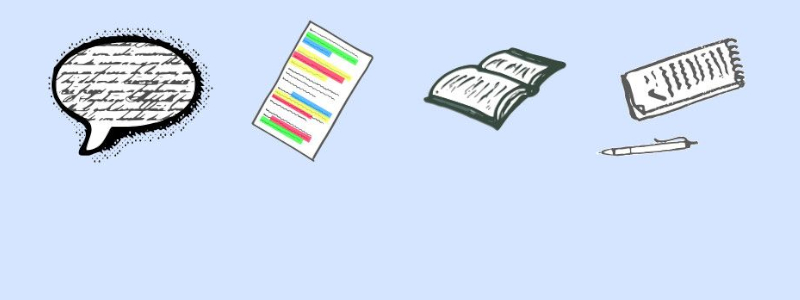Doing Qualitative Research: Gather qualitative data
Setting up your data collection
Gathering data is the phase that some students spend most of their time doing or thinking about, and there's a risk of spending far too long on this phase. To do quality, robust qualitative research you must spend time thinking about, planning and doing all phases of the research. Remember that our research model is cyclical and iterative. Therefore in qualitative research it is normal to start analysing data and use this to inform how the data continues to be gathered and what might need to be focused on, or changed, to better serve the purpose of the research.
It is possible to just add space for open responses on questionnaires and call this qualitative research. But data-gathering methods in qualitative research are some of the most interesting, flexible, creative and even enjoyable ways of engaging with people and creating (and co-creating) new insight and knowledge. One of the most common ways to get insight into a person’s experience is to hear their story through an interview, (sometimes combined with visual, auditory or kinetic elicitation devices or prompts).
What is your experience of interviews and how might that be different to doing a research interview in your current project?
- Reflect on your experience; use a mind map or make some notes
- Discuss with colleagues
Some start with under-estimating the complexity of research interviews and say things like:
- “Well, it’s just a chat, isn’t it?”
- “I ask a question, they answer, right?”
- “I talk to people all the time as part of my job, how hard can it be?”
Others are almost paralysed by the fear of the "what if?"s:
- “What if I say the wrong thing?”
- “What if they don’t say anything?”
- “What if the batteries run out?”
Most will experience some mild anxiety around coming away from the interview with usable research data and behaving professionally. We can offer you tips on how to approach interviewing but there are as many contexts for interviewing as there are contexts, so it is important to prepare for your context.
- Take a moment to look at the visuals above. Think and reflect about the context for your research. Look back or add notes, using the Socratic questions shown to the left above and in ✏️ Design and plan. You may already have added to your notes during your reflections in 💭 Epistemology and Meta issues.
Types of qualitative data
Before you commit yourself to gathering your data as a written transcript of a recording of an interview, take a look at the range of possibilities of what constitutes data in qualitative research in our blog below: such as interview notes, thematic highlights, physical artefacts, videos, e.g. of a performance, policy document. You can even see some of the differences in how speech is transcribed.
In the field
Notes and observations
It is easy to be beguiled into thinking that digital recording devices will capture everything and that your notes are either irrelevant as data or not very important. This is simply not the case. You will need to have some kind of system in place for keeping a record of the things that cannot be captured on recording devices, such as:
- Contextual information and atmosphere
- Your thoughts and feelings
- Things that you wish to come back to later; either during this data capture event, or at a later date
- Analytical thoughts and ideas; you may wish to share them with participants or simply make a note for later
- Anything that you notice during the course of data gathering, even if you can’t think of an explicit reason for doing so; you just have a feeling that it’s worth noting.
Typically in Ethnography, where everyday contexts are being observed, field notes will be “a detailed chronicle by an ethnography of events, conversations, and behaviour, and the researcher’s initial reflections on them”.[1]
Bryman reminds us that you may not be able to make notes during a data gathering event; you may be witnessing or recording a fast moving event where note-taking is inappropriate, or distracting. The furious scribblings that you make immediately following the event, such as in the car once an interview or filming is complete, or back at your hotel room (or mosquito infested tent) that same evening, are field notes. Once a few hours have passed, the reliability of your memory and the recall of your notes as primary data comes into question. These notes are more likely to be called reflections or analytical notes, or even recollections. You can still use them, just be clear and honest about when the notes were made. You must build the templates that are fit for your research context, but it is helpful to see how other people have done it and adapt for your own contexts.
Examples
It can be a good idea to have some sort of aide memoire, whatever your data collection context. You might choose to have a standardised section for every event, such as items you need to take with you, or phrases and things you will use (e.g. spare batteries and consent form, participant para-data) and a section that is unique to each collection event.
Whilst their emphasis is on the analysis of qualitative data, Miles & Huberman[2] have always given lots of examples and templates that really give you an insight on how you could be thinking about systematising your notes and observations. If the latest edition (with Johnny Saldaña[3]) is not available from your library, the earlier editions have just as many great templates to explore and prompt your thinking.
Look at the examples above, then:
- Reflect in your notebook
- Discuss and share helpful examples amongst colleagues
Adapt our examples (don't copy; your context may be similar but it is unique) or create your own data gathering Aide-Memoire and simple template for gathering notes.
Asking questions
A research interview is not an interrogation. We do not fire questions at people. We aim for a more conversational style. And even if you are only using observational methods, you will almost certainly need to ask questions at some point. The blog below covers getting people to talk naturally and has some examples of how to elicit talk, including some questioning techniques.
Etiquette: your behaviour as a researcher
It can be a bit daunting and awkward engaging with your research participant. What was quite a natural exchange when you first contacted them, perhaps over email, now holds all the awkwardness and expectation of a first date! The blog below covers most of the matters of etiquette by focusing on interviews in other people’s homes.
Staying safe

It is appreciated that some qualitative research, especially around natural disasters, conflict and criminality takes place in some very physically dangerous situations. But for most of us it is more common threats like a fall or verbal abuse that we may face. But that’s no reason to be complacent, especially as so many of us research alone. Use the blog to consider your safety.
Just in case I’ve alarmed you, there is an optional blog below to help you plan for your safety in public and private spaces.
Psychological safety and wellbeing
Health and safety policies have typically focused on physical safety, but the past few years has seen increasing emphasis on psychological and emotional wellbeing at policy level. This means that you are more likely to have access to some form of guidance, and an expectation that you will have considered well-being in your protocols and ethics reviews (for yourself and participants), especially if you are researching sensitive or emotive topics.
However, in our Qualitative Researcher Journeys project, Jackie[4] talks about how topics can ‘blind-side you’ during interviews: i.e. suddenly something will be mentioned or said that causes an unexpected emotional response in you, even if the research topic is considered to be ‘safe’. What will affect you on one day, may not on the next. So if you do find yourself ‘blind-sided’, it is OK to take a moment or and step away if you need to; ask to go to the toilet. If you have sufficient rapport, you may feel it is appropriate to share for a moment or two. Sometimes it’s enough to simply take a sip of water to recover your equilibrium. Do reflect on such things in your research journal, and do talk it through with someone. Seek help from institutional services, such as Mental Health First Aiders, or counselling services, if you think it will continue to affect you.
Look back at your notes from Ethics and risk assessment.
- Have you considered the physical and psychological wellbeing of yourself and your participants?
- Add some more of your thoughts
Where next?
You might be in a hurry to gather all your data. But having some idea of how you might analyse your data before you gather it is important. So we advise going on to 💻 Manage and handle and ❔ Analyse and transform before you collect your data. Remember that qualitative research is an iterative process, so don’t wait to finish collecting data before you start analysing it; move back and forth between collection and analysis, and use what you have learnt from analysis to inform your data gathering. Click on the model at the top of the page if you want to go somewhere else next; it’s your choice.
Tell us what you think!
We'd love to hear from you so we can make this course as useful as possible. If you'd like to leave feedback, suggestions or comments, please use the button below.
Fill out our surveyCitations
[1] Bryman, A. (2004) Social research methods (2nd ed). Oxford University Press, New York, 592.
[2] Miles, M. B. & Huberman, A. M. (1994). Qualitative data analysis: An expanded sourcebook (2nd ed). Sage Publications.
[3] Miles, M. B., Huberman, A. M. & Saldana, J. (2018) Qualitative Data Analysis: A Methods Sourcebook (4th ed). Sage.
[4] Jackie (2021) Interview Transcript. Qualitative Researcher Journeys Project.
How to cite this course
A simple bibliographic reference (where you are not citing anything in particular from the course) can be given as:
- Gibbons, C.A. (2024) Doing Qualitative Research. Quirkos.com https://www.quirkos.com/curated-course/index.html
However, if you are citing or quoting from the course content then the full URL should be given in the Reference section. E.g. If you want to cite the text or exercises around Ethics, the citation would be:
- Gibbons, C.A. (2024) Doing Qualitative Research. Quirkos.com https://www.quirkos.com/curated-course/epistemology.html#EthicalReview
Click here for more information on how to cite resources from Quirkos.
Try today!
Ready to give Quirkos a try? Register for a free 14-day trial of Quirkos today,
with no restrictions on features or
projects.with no restrictions on features or
projects.
Want to learn more? Read more about our features or see Quirkos in action!





